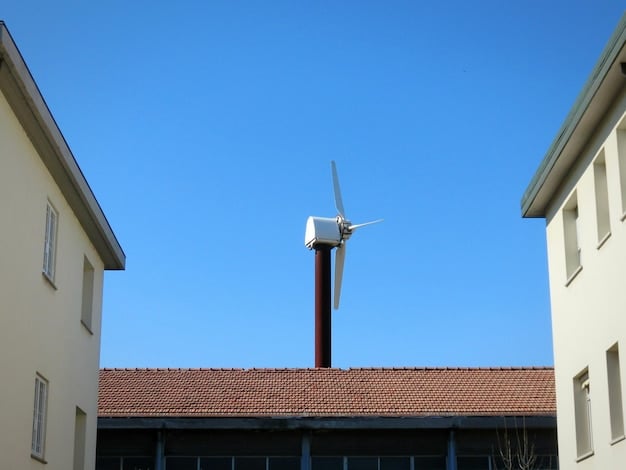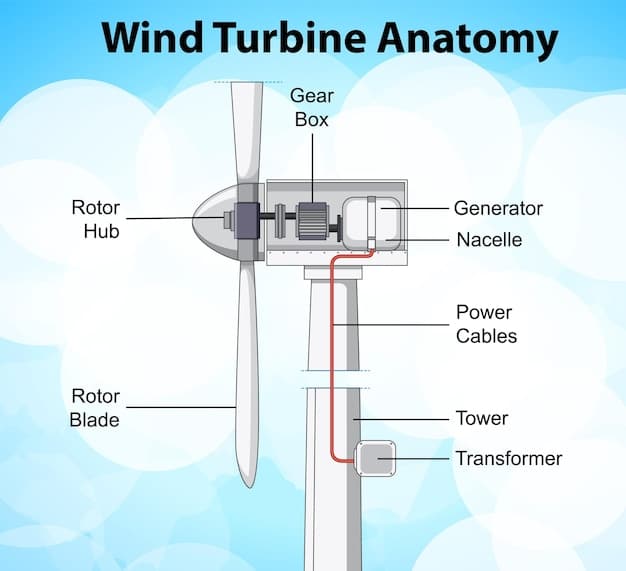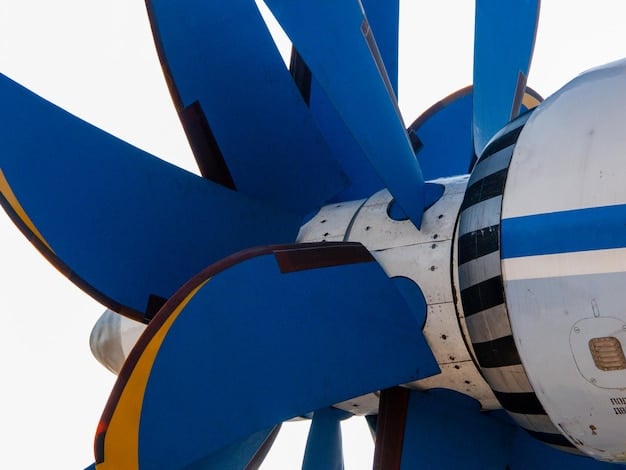Small-Scale Wind Turbines: A Viable Option for US Homeowners in 2025?

Small-scale wind turbines present a potential solution for US homeowners seeking renewable energy in 2025 by reducing electricity costs and promoting sustainability, but factors like initial investment, local regulations, and environmental impact must be carefully considered to determine their viability.
Are small-scale wind turbines a viable option for homeowners in 2025? As the push for sustainable energy solutions intensifies, many US homeowners are exploring ways to reduce their carbon footprint and lower electricity bills.
Understanding Small-Scale Wind Turbines
Homeowners are increasingly considering alternative energy sources. Among them, small-scale wind turbines are gaining traction. Understanding the basics is crucial before deciding if they are a fit for your property.
What is a Small-Scale Wind Turbine?
A small-scale wind turbine is a miniature version of the large wind farms you often see in rural areas. These turbines are designed to generate electricity for a single home or small business.
Components of a Home Wind Turbine
A typical home wind turbine system consists of several key components working together to convert wind energy into electricity.
- Rotor Blades: These are the visible blades that catch the wind and begin the energy conversion process.
- Turbine: The turbine is the central generator that converts the rotational energy of the blades into electrical energy.
- Tower: The tower supports the turbine and lifts it to a height where it can capture more consistent and stronger winds.
- Inverter: This device converts the direct current (DC) electricity produced by the turbine into alternating current (AC) electricity, which can be used in homes.
Overall, small-scale wind turbines offer a potential way for homeowners to generate their electricity and reduce their reliance on traditional energy sources.

The Economics of Home Wind Turbines in 2025
A significant factor for homeowners considering small-scale wind turbines is the financial aspect. Evaluating the cost and potential savings is essential to determine if it’s a sound investment.
Initial Investment: What to Expect
The initial cost of purchasing and installing a small-scale wind turbine can vary considerably. Prices depend on several factors including the size of the turbine, the height of the tower, and the complexity of the installation.
Potential Savings on Electricity Bills
One of the primary benefits of installing a small-scale wind turbine is the potential to reduce your monthly electricity bill. The amount you save will depend on how much electricity your turbine generates.
- Wind Availability: The more consistent and stronger the wind is in your area, the more electricity your turbine will produce.
- Turbine Size: Larger turbines can generate more electricity.
- Electricity Consumption: The more electricity you use in your home, the more you can save by offsetting that usage with wind power.
Careful evaluation of these factors is crucial to making an informed decision.
Environmental Impact and Sustainability
Besides costs, the environmental impact is a key consideration when evaluating small-scale wind turbines. Understanding their effect on the environment is vital for making a responsible choice.
Reducing Carbon Footprint
One of the most significant environmental benefits of using small-scale wind turbines is the reduction in your carbon footprint. By generating your electricity from wind, you reduce the demand for electricity.
Impact on Wildlife and Ecosystems
While wind energy is generally considered environmentally friendly, it’s not without potential drawbacks. One concern is the impact on local wildlife and ecosystems.
- Bird and Bat Fatalities: Wind turbines can pose a risk to birds and bats, which may collide with the rotating blades.
- Noise Pollution: Wind turbines can produce noise, which may disturb nearby residents or wildlife.
- Visual Impact: Some people find wind turbines visually unappealing, which can affect the aesthetics of the landscape.
By addressing these concerns and implementing mitigative strategies, it’s possible to minimize the environmental impact of small-scale wind turbines.
Regulatory and Legal Considerations for US Homeowners
Navigating the regulatory landscape is a critical step in determining the viability of small-scale wind turbines. Understanding the legal requirements ensures a smooth and compliant installation.
Local Zoning Laws and Permits
Before installing a small-scale wind turbine, it’s essential to check with your local zoning authorities to understand any restrictions.
Net Metering Policies and Incentives
Net metering policies allow homeowners to send excess electricity generated to the grid in exchange for credits on their electricity bill.
- State Policies: Some states have mandatory net metering policies, while others leave it up to the utility companies to decide.
- Incentive Programs: Many states and the federal government offer incentives, such as tax credits and rebates, to promote the installation of renewable energy systems like wind turbines.
Thoroughly researching these policies and incentives can significantly impact the financial viability of your wind turbine project.
Technological Advancements in 2025
The technology behind small-scale wind turbines is continuously evolving. Keeping abreast of the latest advancements is essential for making an informed decision.
Improved Turbine Designs and Efficiency
Ongoing research and development efforts are focused on improving the design and efficiency of small-scale wind turbines. These advancements translate to better performance and greater energy production.
Smart Grid Integration
The rise of smart grid technologies is enabling more seamless integration of small-scale wind turbines with the existing power.

Is Wind Energy Right for Your Home? Assessing Viability
Deciding whether a small-scale wind turbine is right for your home in 2025 involves a comprehensive assessment. Considering your specific needs and conditions is crucial.
Wind Resource Assessment
Understanding the wind resource at your location is the first step in determining the viability of a wind turbine.
Home Energy Consumption Analysis
Another essential step is to analyze your home’s energy consumption patterns. This will help you determine how much electricity you need to generate.
Long-Term Maintenance and Reliability
It’s important to consider the long-term maintenance requirements and reliability of small-scale wind turbines. Regular maintenance helps ensure optimal performance and extends the lifespan.
| Key Point | Brief Description |
|---|---|
| 💰 Initial Investment | Cost varies, needs careful financial planning. |
| 🌎 Environmental Impact | Reduces carbon footprint but may affect wildlife. |
| 📜 Regulatory Compliance | Zoning laws and permits crucial to navigate. |
| ⚡ Energy Savings | Potential for significant electricity bill reduction. |
FAQ
▼
The cost varies widely based on size, tower height, and installation complexity, typically ranging from $3,000 to $8,000 per kilowatt. A 10kW turbine could cost between $30,000 and $80,000 installed.
▼
Ideal conditions include consistent wind speeds averaging at least 9-14 mph. An open location away from trees and buildings is essential to maximize energy production.
▼
Yes, many states and the federal government offer incentives such as tax credits, rebates, and grants. The Database of State Incentives for Renewables & Efficiency (DSIRE) provides detailed information.
▼
Most turbines require annual inspections to check for wear and tear on blades and components. Lubrication and occasional repairs are also necessary to ensure optimal performance.
▼
Yes, net metering policies allow homeowners to sell excess electricity back to the grid. The specifics vary by state and utility company, so it’s important to check local regulations.
Conclusion
In conclusion, while small-scale wind turbines offer a promising avenue for US homeowners seeking renewable energy in 2025, their viability hinges on careful evaluation of factors such as cost, environmental impact, regulatory compliance, and technological advancements. By thoroughly assessing these aspects, homeowners can make informed decisions that align with their energy needs and sustainability goals.





